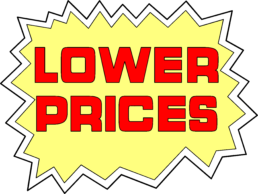Pricing Strategies: How do I know how much to charge?
To view this article in video form, visit our YouTube channel.
One of the hardest decisions a new business owner makes is how much to charge. In calculating the "right" price, there are a number of variables to consider.
 For starters, let's re-visit Intro to Microeconomics and ask, is your product elastic, or inelastic? Elastic products are those goods or services in which demand is closely tied with price. In other words, demand on an elastic product will increase with a decrease in price, and vice versa. The demand for inelastic goods is steadier, and less dependent on price.
For starters, let's re-visit Intro to Microeconomics and ask, is your product elastic, or inelastic? Elastic products are those goods or services in which demand is closely tied with price. In other words, demand on an elastic product will increase with a decrease in price, and vice versa. The demand for inelastic goods is steadier, and less dependent on price.
For example, a specific brand of chocolate chips is a highly elastic good. If the price increases too much, customers will just purchase a different brand of chocolate chip (or decide to bake a different type of cookies, or just buy the pre-made cookies outright). Though I might really like Ghirardelli brand chocolate chips, I don't really need them, and there are plenty of ready substitutes available.
A very inelastic product would be gasoline. The price tends to be relatively uniform within a geographic area, and most people are heavily reliant on it in their day-to-day lives. Even when the price surges, consumers still have to purchase a certain amount. Likewise, even when gasoline is very cheap, people don't necessarily start driving and purchasing significantly more.
If your product is elastic, you don't necessarily have to have one set price. You could employ "surge" pricing, a la Uber, and charge more when your goods or services are in greater demand. You can also try to generate increased demand through temporary price drops. (Perhaps some of you are old enough to remember "blue light specials".) If you want to keep steady prices, or if you're good is inelastic, there are other variables to consider.
To develop a pricing strategy, you should know your variable expenses, how to calculate profit margin, and have a general idea of market price (competitors' prices).
Maybe you have a surface familiarity with the terms "variable expenses" and "profit margin", but aren't 100% clear on how they're calculated. For your benefit, we'll have a quick accounting lesson.
 Variable expenses are those expenses which are directly tied to the production of each unit of a product, and might include such expenses as raw materials, labor hours, and shipping costs. In other words, variable expenses increase (or vary) as production increases. Costs of Goods Sold (or COGS) are variable expenses.
Variable expenses are those expenses which are directly tied to the production of each unit of a product, and might include such expenses as raw materials, labor hours, and shipping costs. In other words, variable expenses increase (or vary) as production increases. Costs of Goods Sold (or COGS) are variable expenses.
To calculate your profit margins, divide your net profit (sales - COGS) by your sales. Playing with these formulas at different prices can help you determine a feasible price for your product.
As far as competitive pricing, it is good to be in a range with your market competitors, though you don't necessarily have to be the cheapest, or even on the lowest end. Trying to win customers on price alone can cause a big hit to your profit margins, and will not bring you long-term success. If you cannot safely price your competitors out, beat them with a distinguished product and superior customer service.
Finally, there are discounts to consider, particularly "friends and family" pricing. Special pricing is fine, as long as you can still maintain healthy margins. Never sell at a loss, even for those close to you. You do not want to have to raise prices on friends and family later, so set them at a level you can maintain indefinitely. If you price yourself out of business, you really aren't doing your loved ones any favors.
Stop Eating Frogs
Mark Twain famously said, “Eat a live frog first thing in the morning and nothing worse will happen to you the rest of the day.” In recent years this has become a particularly popular sentiment amongst entrepreneurs, used as a reminder to not procrastinate in completing disliked chores. Small business owners typically have to manage so many different aspects of their company, it's inevitable that there will be some tasks they dread.
For many, their "frog" is accounting.
But, here's the secret...for some people, frog is a delicacy.
We may be in the minority, but, at The Bookkeeper, accounting and finance aren't just something that pays the bills. We actually find a lot of it fun.
Here are a few of our services which, though business owners typically find distasteful, we really enjoy.
 Developing Business Procedures
Developing Business ProceduresYou know the only thing more fun than reading a collections procedure manual? Writing a collections procedure manual. It combines several of the things we love, like research, technical writing, and custom-tailoring business practices to an individual company. What's not to love?
Of course, we've heard some people refer to research as "boring" or technical writing as "tedious". But we feel the same way about SEO optimization and, apparently, some people enjoy that.
Budgeting
Budgeting seems to have a negative connotation for a lot of people. A budget is seen as something constraining. But we think budgeting is awesome. You get to look at all your revenues and expenses, and figure out where you can save or earn more money. Who doesn't like having more money? A budget lets you make plans and take steps to achieve your goals. Not knowing your budget is like driving blindfolded. Maybe exciting for some, but too risky for us.

Debt Repayment Plans
A lot of people who are in a great deal of debt don't like to think about how much debt they're in. Of course, ignoring a problem doesn't make it go away.
For business owners overwhelmed by debt, figuring out a way to repay it all is too big a frog to eat. Much easier to just make the minimum payments and try not to think too hard about those rising balances. Fortunately, we love writing debt repayment plans.
Like so many problem, debt seems a lot bigger when you're in the middle of it. That's why we enjoy taking an objective, mathematical look at the problem, and coming up with a tangible, step-by-step solution to eliminating it. And it is so exciting to show someone how they can, often without even spending additional money, be debt-free and have savings built up in, frequently, as little as five years.

Profitability Analysis & Pricing Strategies
Some people may be put off from some aspects of accounting because of the math involved, particularly when it comes to things like calculating gross profit margins. We at The Bookkeeper are huge fans of math, perhaps because of its consistency and objectivity or, perhaps, as the great philosopher Cady Heron stated, "Because it's the same in every country." (Yes, both Mark Twain and "Mean Girls" quotes in one article. Small business accounting can be very culturally relevant.)
Math is especially useful when it comes to looking at which products or services provide higher revenues or greater returns, and where prices can be raised to improve profitability. Using a little bit of math and research to make more money, without having to sell more or perform more work? That's fun.

These are just a few of the services we provide for our clients, not just because our clients find them difficult or loathe doing them, but because we actually do find them interesting. Where the client sees a live frog, we see a perfectly seared filet mignon.
If there's some chore in your business which you simply despise completing on a daily basis, whether it's finance-related or something else, consider whether it's worth it to you to pay someone else to eat that frog.
You're in business for yourself, so why do something you hate?


